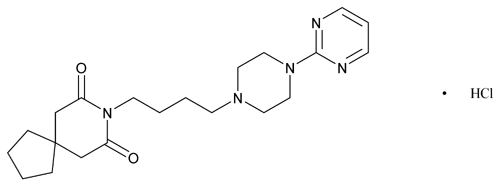Buspirone Hydrochloride
8-Azaspiro[4,5]decane-7,9-dione, 8-[4-[4-(2-pyrimidinyl)-1-piperazinylbutyl-, monohydrochloride.
N-[4-[4-(2-Pyrimidinyl)-1-piperazinyl]butyl]-1,1-cyclopentanediacetamide monohydrochloride
» Buspirone Hydrochloride contains not less than 97.5 percent and not more than 102.5 percent of C21H31N5O2·HCl, calculated on the as-is basis.
Packaging and storage—
Preserve in tight, light-resistant containers, at controlled room temperature.
Identification—
B:
The relative retention time of the major peak in the chromatogram of the Assay preparation corresponds to that in the chromatogram of the Standard preparation, as obtained in the Assay.
Water, Method I  921
921 :
not more than 0.5%.
:
not more than 0.5%.
Residue on ignition  281
281 :
not more than 0.5%.
:
not more than 0.5%.
Heavy metals, Method II  231
231 :
not more than 0.002%.
:
not more than 0.002%.
Content of chloride—
Dissolve about 400 mg, accurately weighed, in 20 mL of water. Add 3 mL of nitric acid and 20.0 mL of 0.1 N silver nitrate VS. Gently boil the mixture for about 5 minutes. Filter, rinse the flask with about 80 mL of water divided into small portions, and filter each portion. Add 2 mL of 8% ferric ammonium sulfate. While stirring rapidly, titrate the excess silver nitrate with 0.1 N ammonium thiocyanate VS from a buret to a faint red-brown endpoint. Perform a blank determination (see Residual Titrations under Titrimetry  541
541 . Each mL of 0.1 N silver nitrate consumed is equivalent to 3.545 mg of chloride: between 8.0% and 8.8% is found.
. Each mL of 0.1 N silver nitrate consumed is equivalent to 3.545 mg of chloride: between 8.0% and 8.8% is found.
Assay—
Buffer solution—
Transfer 1.36 g of monobasic potassium phosphate to a 1000-mL volumetric flask, dissolve in and dilute with water to volume, and mix. Adjust the solution with 10% sodium hydroxide (w/v) to a pH of 7.5, and filter.
Mobile phase—
Prepare a filtered and degassed mixture of Buffer solution and acetonitrile (60:40). Make adjustments if necessary (see System Suitability under Chromatography  621
621 ).
).
Internal standard solution—
Prepare a stock solution of propylparaben in methanol having a concentration of 2.5 mg per mL. Dilute 25.0 mL of the stock solution quantitatively with water to 500.0 mL, and mix.
Standard stock solution—
Transfer about 50 mg of USP Buspirone Hydrochloride RS, accurately weighed, to a 100-mL volumetric flask, dissolve in 25 mL of 1 N hydrochloric acid, dilute with water to volume, and mix.
Standard preparation—
Transfer 10.0 mL of the Standard stock solution to a 50-mL volumetric flask, add 10.0 mL of Internal standard solution, dilute with water to volume, and mix.
Assay preparation—
Transfer about 50 mg of Buspirone Hydrochloride, accurately weighed, to a 100-mL volumetric flask, add 25 mL of 1 N hydrochloric acid, dilute with water to volume, and mix. Transfer 10.0 mL of this solution to a 50-mL volumetric flask, add 10.0 mL of the Internal standard solution, dilute with water to volume, and mix.
Chromatographic system (see Chromatography  621
621 )—
The liquid chromatograph is equipped with a 254-nm detector and a 3.9-mm × 30-cm column that contains packing L1. The flow rate is about 2 mL per minute. Chromatograph the Standard preparation, and record the peak responses as directed for Procedure: the resolution, R, between buspirone hydrochloride and the internal standard is not less than 4; and the relative standard deviation determined from the buspirone peak response for replicate injections is not more than 2.0%.
)—
The liquid chromatograph is equipped with a 254-nm detector and a 3.9-mm × 30-cm column that contains packing L1. The flow rate is about 2 mL per minute. Chromatograph the Standard preparation, and record the peak responses as directed for Procedure: the resolution, R, between buspirone hydrochloride and the internal standard is not less than 4; and the relative standard deviation determined from the buspirone peak response for replicate injections is not more than 2.0%.
Procedure—
Separately inject equal volumes (about 25 µL) of the Standard preparation and the Assay preparation into the chromatograph, record the chromatograms, and measure the responses for the major peaks. The relative retention times of propylparaben and buspirone hydrochloride are about 0.55 and 1.0, respectively. Calculate the quantity, in mg, of C21H31N5O2·HCl in the portion of Buspirone Hydrochloride taken by the formula:
500C(RU / RS)
in which C is the concentration, in mg per mL, of USP Buspirone Hydrochloride RS in the Standard preparation; and RU and RS are the peak response ratios of buspirone hydrochloride to propylparaben obtained from the Assay preparation and the Standard preparation, respectively.
Auxiliary Information—
Please check for your question in the FAQs before contacting USP.
Chromatographic Column—
| Topic/Question | Contact | Expert Committee |
| Monograph | Ravi Ravichandran, Ph.D.
Senior Scientist 1-301-816-8330 |
(MDPP05) Monograph Development-Psychiatrics and Psychoactives |
| Reference Standards | Lili Wang, Technical Services Scientist 1-301-816-8129 RSTech@usp.org |
USP32–NF27 Page 1726
Pharmacopeial Forum: Volume No. 31(3) Page 742
Chromatographic columns text is not derived from, and not part of, USP 32 or NF 27.
